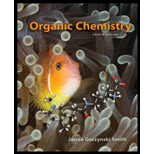
(a)
Interpretation: The types of intermolecular forces present in acetic acid and sodium acetate are to be stated.
Concept introduction: According to Bronsted-Lowry theory, when an acid donates a proton the species formed is known as conjugate base and when the base accepts a proton the species formed is known as conjugate acid.
The intermolecular forces are the forces that exist in between the two or more atoms in a compound. Due to strong intermolecular forces, the molecule will require more energy to break the bonds.
(b)
Interpretation: An explanation corresponding to the fact that the melting point of sodium acetate is higher than the melting point of acetic acid is to be stated.
Concept introduction: The melting point of compounds depends upon the molecular weight and the intermolecular forces present in the compounds. The intermolecular forces are the forces that exist in between the two or more atoms in a compound. Due to strong intermolecular forces, the molecule will require more energy to break the bonds. The compounds that have ionic bonding and hydrogen bonding will possess higher melting point.
Want to see the full answer?
Check out a sample textbook solution
Chapter 3 Solutions
Package: Organic Chemistry With Connect 2-semester Access Card
- Describe the formation of hydrogen bonds in propanol, CH3CH2CH2OH. Represent possible hydrogen bonding structures in propanol by using structural formulas and the conventional notation for a hydrogen bond.arrow_forwardExplain why the melting point of methyl fluoride, CH3F (-142°C), is higher than the melting point of methane, CH4 (-182°C)?arrow_forwardorganic chemistry 5) The compound with the lowest boiling point is:arrow_forward
- What INTER-molcular forces does an acetate ion (CH3CO2-) have? I know it has LDF's but since it's an anion can it only form ionic attractions and ion-dipole forces?arrow_forwardwhat are the boiling points of MgCl2 and H2S?arrow_forwardPropyl alcohol (CH3CH2CH2OH) and isopropyl alcohol[(CH3)2CHOH], whose space-filling models are shown,have boiling points of 97.2 and 82.5 °C, respectively.Explain why the boiling point of propyl alcohol is higher,even though both have the molecular formula, C3H8O.arrow_forward
- What is the enthalpy change when 1.00g of water is frozen at O⁰C? ∆H?ᵤₛᵢₒₙ =1.433 80Kcal/mol.arrow_forward2. Which of the following has the highest boiling point? A. NaCl B. HBr C. CH3CH2CH3 D. CCl4arrow_forwardRubbing alcohol is the common name for 2-propanol (iso- propanol), C3H7OH. (a) Draw the three-dimensional structure of the 2-propanol molecule and predict the geometry around each carbon atom. (b) Is the 2-propanol molecule polar or nonpolar? (c) What kinds of intermolecular attractive forces exist between the 2-propanol molecules? (d) The isomer 1-propanol has the same molecular weight as 2-propanol, yet 2-propanol boils at 82.6 °C and 1-propanol boils at 97.2 °C. Explain the difference.arrow_forward
 General Chemistry - Standalone book (MindTap Cour...ChemistryISBN:9781305580343Author:Steven D. Gammon, Ebbing, Darrell Ebbing, Steven D., Darrell; Gammon, Darrell Ebbing; Steven D. Gammon, Darrell D.; Gammon, Ebbing; Steven D. Gammon; DarrellPublisher:Cengage Learning
General Chemistry - Standalone book (MindTap Cour...ChemistryISBN:9781305580343Author:Steven D. Gammon, Ebbing, Darrell Ebbing, Steven D., Darrell; Gammon, Darrell Ebbing; Steven D. Gammon, Darrell D.; Gammon, Ebbing; Steven D. Gammon; DarrellPublisher:Cengage Learning Introduction to General, Organic and BiochemistryChemistryISBN:9781285869759Author:Frederick A. Bettelheim, William H. Brown, Mary K. Campbell, Shawn O. Farrell, Omar TorresPublisher:Cengage Learning
Introduction to General, Organic and BiochemistryChemistryISBN:9781285869759Author:Frederick A. Bettelheim, William H. Brown, Mary K. Campbell, Shawn O. Farrell, Omar TorresPublisher:Cengage Learning

